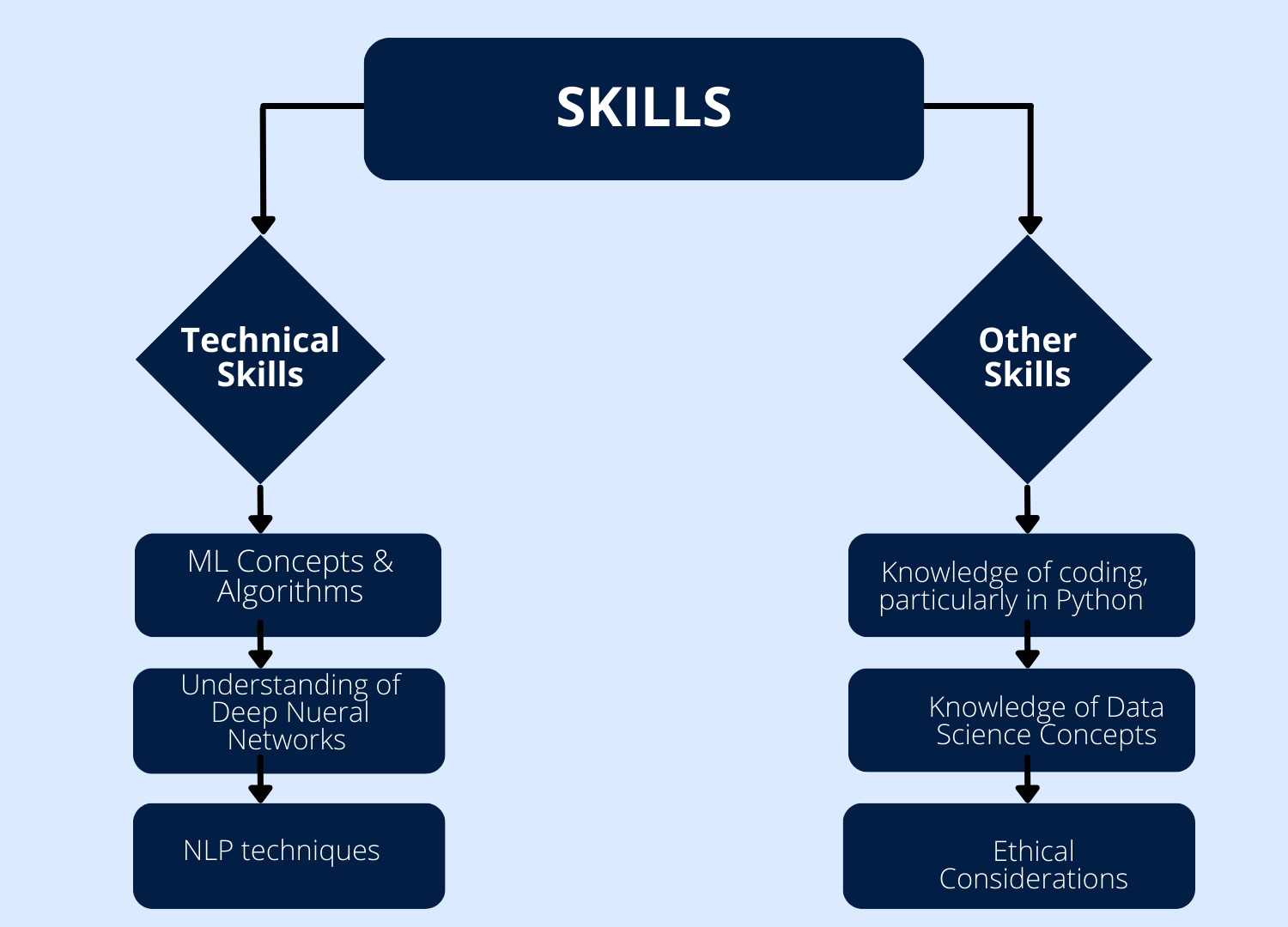Table of Contents
Building a GenAI LLM like ChatGPT requires a blend of cutting-edge natural language processing techniques, machine learning algorithms, and a vast dataset for training. GenAI LLM is a creative technology that permits organizations to deal with the privileges related to their language models successfully. Overall, we will explore the key advances engaged with building a GenAI LLM like ChatGPT and explore the fundamental parts and considerations.
According to recent market reports, the AI market is expected to grow in value from $11.3 billion in 2023 to $51.8 billion by 2028. With ChatGPT setting a record as the fastest-growing internet app in history, it is safe to assume that AI and LLMs are here to stay and will continue to develop at an exponential rate.
To realize the impact LLMs are having on the marketplace, it is crucial to have an understanding of the LLM market and how it is transforming industries worldwide.
An Overview
In recent years, there has been a critical progression in NLP strategies, encouraging the improvement of exceptionally refined language models. Furthermore, one such advancement model is OpenAI’s ChatGPT, which uses deep learning calculations to create human-like responses in conversational settings.
ChatGPT has acquired immense fame because of its capacity to reproduce clever discussions and help clients with different tasks like addressing questions or participating in casual conversation.
Building a GenAI LLM like ChatGPT requires a deep understanding of NLP ideas and skills in AI. Overall, it includes preparing an enormous brain network on massive measures of text data to produce logical answers.
To recreate the outcome of the chatbot large language model, it is critical to use the most recent information in the field of NLP. Furthermore, this incorporates gathering different and empowering datasets that cover many subjects and discussion styles.
Access to a huge ship of messages from different sources, for example, books, articles, online posts, and online discussions is fundamental for preparing the GenAI LLM. Furthermore, remaining updated with the most recent analysis papers, methods, and models in NLP is essential to integrate them into the improvement of a GenAI LLM like ChatGPT.
The field of NLP is under development, with new advancements being made consistently. Furthermore, staying up with the latest with these advancements guarantees that the GenAI LLM stays important and cutthroat.
Besides, pre-preparing the model on an immense measure of data permits it to gain proficiency with the factual examples present in regular language. This pre-preparing stage assists the model with stimulating areas of strength for information.
Are You Curious About Large Language Models For Your Project?
Reach Out To Our Experts For Personalized Consultation
What Are Large Language Models (LLM)?
Large Language Models (LLMs) are a kind of AI models that have essentially progressed the field of NLP and generation. Overall, they are processing and creating human-like text at an amazing scale.
LLMs stand out enough to be noticed because of their capacity to understand and answer normal language inquiries. However, making them important for different applications, including, chatbots, personal assistants, content creation, and interpretation are equally important.
A few major issues to understand about LLMs include:
-Multimodal LLMs can be inclined to biases in the data they are prepared on, which can produce one-sided predictions and build up existing social differences.
-Understanding how multimodal LLMs pursue choices is trying because of their complicated design, making it hard to make sense of their thinking and possible inclinations.
-The utilization of multimodal LLMs raises moral worries connected with protection, assent, and expected misuse of innovation.
-Multimodal LLMs might need variety in their preparation of data, bringing about one-sided or restricted points of view and reports. It can create content that looks like a human way of behaving, bringing up issues about validness and responsibility regarding the produced yield.
-Multimodal LLMs might battle with adding up to hidden facts or circumstances, restricting their relevancy and adequacy in certifiable situations.
-Building and preparing multimodal LLMs require critical computational investments and data, making them remote for some organizations or scientists.
-Multimodal LLMs can be vulnerable to malicious attacks, where malignant entertainers control contributions to deceive or take advantage of the model’s dynamic interaction.
-Deciding responsibility for the activities and choices made by multimodal LLMs can be a challenge, as the responsibility might lie with various partners including the engineers, clients, and organizations executing the innovation.
Challenges Of LLM
Building open-source large language models with the capacities of ChatGPT, like OpenAI’s GPT-3, includes a few difficulties. Overall, these difficulties can influence the model’s exhibition and pose obstacles for developers. The following are seven critical difficulties in building a strong Language Learning Model (LLM):
1) Data quality:
LLMs require a huge measure of preparation information to gain from.
2) Computational assets:
Preparing LLMs like ChatGPT requires critical computational assets, including strong GPUs and high-limit capacity. Overall, these assets can be expensive and may not be promptly accessible to all prompt engineers.
3) Ethical considerations:
Generative AI tools can create one-sided or improper software, as they gain from the information given to them. Overall, prompt engineering services should cautiously organize the preparation data and carry out measures to keep the model from creating unsafe or malicious results.
4) Contextual understanding:
LLM machine learning might battle with figuring out the setting, particularly in mind-boggling or equivocal circumstances. They might deliver responses that appear to be intelligent however need a genuine understanding of the hidden importance.
5) Lack of common sense knowledge:
LLMs don’t have innate good judgment data, which can evoke false or deceiving responses. They depend exclusively on the data that is been prepared and may battle to give detailed responses or clarifications in circumstances that require general information or thinking.
6) Bias amplification:
LLMs can unexpectedly boost biases present in the preparation data, producing one-sided results. Furthermore, this can support out-of-line generalizations or unfair ways of behaving, making it critical for creators to carry out bias recognition and restraint methods to guarantee reasonableness and inclusivity in the model’s responses.
7) Interpretability and Explainability:
LLMs are black box models, implying that they understand how they show up at their choices or produce clear results. Overall, this absence of interpretability can raise concerns regarding responsibility, straightforwardness, and reliability in applications where the model’s dynamic process should be logical and justifiable.
These generative AI services feature the complexity and limits of building LLMs like ChatGPT. Overall, engineers should address these difficulties to make solid models that can successfully understand and produce human-like responses.
Defeating these obstacles requires a mix of specialized proficiency, data curation, ethical considerations, and continued innovative work trials. Furthermore, by managing these difficulties, developers can open the maximum capacity of LLM and equip its abilities to drive progress and improve different fields that depend on natural language processing solutions.

How to Build Your LLM Like ChatGPT
Building a language model like ChatGPT requires proficiency in NLP (NLP) and generative AI development. The norms employed in building your language model are as per the following:
1. Data Collection:
Start by collecting a huge dataset of text from different sources, like books, articles, sites, or even visit discussions. The dataset is mixed and covers numerous areas to guarantee the model grasps various sorts of languages and subjects.
2. Model Selection:
Pick a reasonable design for your language model. Well-known decisions incorporate transformer-based models like GPT-3 or LSTM-based models like BERT. Consider the size of your dataset, computational support, and detailed requirements of your task while choosing a model.
3. Training:
Train your language model on the preprocessed dataset utilizing methods like directed or solo learning. This step includes taking care of the information text to the model and changing its boundaries through backpropagation to limit the misfortune capability.
4. Fine-tuning:
After introductory preparation, calibrate your language model on a particular task or space to work on its exhibition and make it more specific. This includes further preparation of the model on a more modest dataset that is for the main job, permitting it to learn task-explicit examples and subtleties.
5. Evaluation:
Consider the presentation of your language model by testing it on a different approval set or utilizing measurements like perplexity or exactness. This step surveys the generative AI vs. large language models capacity to create intelligent and precise responses.
6. Iterative Improvement:
Given the review results, repeat and refine your language model by changing its design, hyperparameters, or preparing strategies. This iterative interaction works on the model’s exhibition and handles any issues or limits distinguished during the analysis.
7. Deployment:
Once happy with the presentation of your language model, convey it for use in your ideal application. This might include incorporating the model into a chatbot stage, a text generation framework, or some other NLP application. Guarantee that the artificial intelligence development company process is undeniable and follows best practices for adaptability, security, and proficiency.
8. Continuous Monitoring and Maintenance:
Monitor the collection of your transmitted language model routinely to distinguish any issues or errors in its presentation. Continue refreshing and retraining the model intermittently to adjust to changing language examples or client requirements.
This ceaseless checking and support process guarantees that your language model’s remaining parts are exact, dependable, and forward-thinking.
Building a language model like ChatGPT is a perplexing and iterative process that requires proficiency in NLP, AI experts, and data curation. By following these means and constantly refining your model, you can make a strong and flexible language model that can create human-like responses and understand an extensive variety of regular language inputs.
Make sure to constantly keep up to date with the most recent advancements in NLP research and be available to incorporate new procedures or models into your language model. With commitment and a deep understanding of NLP, you can manufacture a GenAI LLM like ChatGPT that meets your particular requirements and brings great outcomes.
Discover What Large Language Models (LLMs) Can Bring To Your Business
Contact us for Custom Solutions for You
Various Approaches To Train The LLMs
Preparing language models like ChatGPT model development includes a few stages and contemplations to guarantee ideal execution. Here, we will talk about the most common way of preparing Large Language Models (LLMs) in five approaches.
1. LLM from Scratch:
Making and preparing a space-explicit language model without any preparation is certainly not a typical methodology because of the necessity of a lot of excellent information, figuring power, and prepared information science ability.
Bloomberg is one organization that has effectively utilized this methodology, utilizing 40 years of monetary information and an enormous volume of text from monetary filings and web information. They utilized 700 billion tokens, 50 billion boundaries, and 1.3 million hours of illustrations handling unit time for their model. Hardly any organization approaches such assets.
2. Fine-tuning approach
The Fine-tuning approach is a strategy for preparing a current language model to add specific domain content. It includes changing the parameters of a base model and requires less data and computing time compared with making another model from scratch.
Google utilized this way to deal with training its Med-PaLM2 model for clinical knowledge, which performed overall better as compared to its past variant. Nonetheless, adjusting can in any case be costly and requires ability in data science.
Some argue that it is the most ideal for adding new content designs and styles. Also, not all language model vendors permit fine-tuning on their most recent models.
3. Prompt Tuning of an existing LLM
The most widely recognized way to deal with redoing an LLM for non-cloud vendor organizations is prompt tuning, where the first model is altered utilizing prompts containing domain-specific data.
This approach is proficient and doesn’t need a lot of data. For instance, Morgan Stanley utilized prompt tuning to prepare OpenAI’s GPT-4 model to give exact data to its financial advisors. Unstructured data like text can be changed into vector embeddings for input into the LLM.
Prompt tuning can be mind-boggling and requires data science ability, yet it very well may be practical assuming the required substance is as of now accessible. Morningstar effectively executed prompt tuning and vector embeddings for its Mo research tool for a minimal price.
4. Quality Assurance
A significant part of managing generative artificial intelligence content is guaranteeing quality. Generative Artificial intelligence is commonly known to “hallucinate” often, with assurance realities that are incorrect or nonexistent.
Mistakes of this sort can be dangerous for organizations however could be destructive in healthcare applications. Fortunately, organizations who have tuned their LLMs on domain-specific data have observed that visualizations are to a lesser degree an issue than out-of-the-case LLMs, at any rate on the off chance that there are no drawn-out exchanges or non-business prompt engineers.
Organizations adopting these ways to deal with generative artificial intelligence knowledge management should enable an evaluation methodology.
For example, for BloombergGPT, which is intended for responding to financial and investing inquiries, the framework was set on open dataset financial tasks, sentiment analysis ability, and a set of reasoning and general natural language processing tasks.
The Google Med PaLM2 framework, made to answer patient and doctor clinical inquiries, had a considerably broader examination process, reflecting the criticality of accuracy and well-being in the clinical domain.
Life or death isn’t an issue at Morgan Stanley, yet delivering deep responses to financial and contributing inquiries is critical to the firm, its clients, and its regulators. The responses given by the framework were assessed by human analysts before it was delivered to any clients.
Then, at that point, it was conducted for a very long time by 300 financial experts. As its essential way to deal with progressing assessment, Morgan Stanley has a bunch of 400 “golden questions” to which the right responses are known.
Each time any change is made to the framework, workers test it with the golden questions to check whether there has been any “regression,” or less exact responses.
5. Revise its approach
One of the leaders said, “I can tell you what things are like today. But everything is moving very fast in this area.” New LLMs and new ways to deal with tuning their content are reported every day, as there are new items from vendors with explicit meaning.
Any organization that focuses on installing its insight into a generative AI framework should be ready to update its way of dealing with the issue much of the time. While there are many testing issues engaged with building and utilizing generative AI frameworks, we’re sure that the general advantage to the organization merits the work to address these complications.
Generally speaking, preparing a genAI LLM like ChatGPT includes gathering and preprocessing information, choosing a proper model engineering, preparing the model on a huge and various dataset, and fine-tuning it for explicit projects or spaces.
With cautious thoughtfulness regarding these standards and continuous refinement, it is feasible to manufacture a strong and flexible genAI LLM like ChatGPT. In any case, it is critical to remember that building a LLM requires huge computational support and proficiency in NLP and AI. It could be valuable to look for direction from specialists or influence existing structures and libraries to work on the interaction.
Final Thoughts
Building a GenAI LLM like ChatGPT requires a blend of cutting-edge NLP methods, a huge scope for preparing information, and strong computing assets. Notwithstanding, it is essential to take note that the eventual future of LLMs holds huge potential and difficulties.
A large language model development company has both responsibility and obstacles. As technology keeps on advancing, we can expect considerably more refined artificial intelligence models that push the limits of human-like discussion. These improvements will require continuous innovative work to refine existing methods and investigate unknown methodologies.
One critical area of concentration for future LLMs is working on how they might interpret settings. While ChatGPT has shown great abilities in producing rational responses, it battles with keeping up with long-term memory. Upgrading these views will be critical in making further developed and sensible conversational artificial intelligence services models.
FAQs
1. What is a GenAI LLM?
A GenAI LLM is a high-level chatbot that utilizes deep learning techniques to produce human-like responses and take part in discussions with clients.
2. Can I build a GenAI LLM on my own?
Building a GenAI LLM requires significant proficiency in AI, NLP, and huge-scope deep learning models. It may be a complex and tedious cycle. But, with the right abilities and assets, it is possible to construct your own GenAI LLM.
3. What are the key components of a GenAI LLM?
The vital parts of a GenAI LLM incorporate
- a huge dataset for preparation,
- deep learning model engineering (like transformers),
- strong equipment (GPUs or TPUs) for preparing the model, and
- an apparatus for creating responses given client input.
4. How does a GenAI LLM learn to generate responses?
A GenAI LLM figures out how to create responses by preparing a huge dataset of human conversations. It utilizes deep learning strategies, for example, transformer models, to learn examples and connections in the information. The model is prepared to predict the following word or collection of words. It empowers it to create rational and logically significant responses.
5. Are there any ethical concerns when building a GenAI LLM?
Building a GenAI LLM raises significant moral contemplations, like the potential for one-sided or unsafe responses. It is vital to painstakingly arrange and clean the preparation information to limit inclinations. Also, executing suitable defense and checking services can assist with moderating any likely moral worries.






